MMA’S APPROACH TO DEVELOPING A WALMART MULTI-LEVEL

TABLE AND CONTENT
INTRODUCTION
TYPOLOGY
VERTICAL TRASPORTATION
VERTICAL TRANSPORATION CASE STUDIES
MULTI-LEVEL PARKING PLANNING
MECHANICAL SYSTEM
STRUCTURE
SUSTAINABILITY


INTRODUCTION
TYPOLOGY
VERTICAL TRASPORTATION
VERTICAL TRANSPORATION CASE STUDIES
MULTI-LEVEL PARKING PLANNING
MECHANICAL SYSTEM
STRUCTURE
SUSTAINABILITY
Getting started or better yet, where do we start? A Walmart multi-level is much more complicated than it may seem. Not necessarily complicated in a constructability sense but rather understanding the complexities associated with developing one.
There are many factors in involved from site selections, integration of the various Walmart stakeholders, engineering and specialty consultants, jurisdictional and community approvals, developers, brokers, contractors and many others.
There are various types of deal structures that you need to get yourself thoroughly familiar with and the most common are joint development agreements, Walmart owned, ground Lease and NNN leases.
Team selection should not be taken lightly. The biggest challenges MMA faced while developing the various Walmart multi-levels were challenges associated in utilizing pre-approved engineers that were extremely familiar with the prototype. While these engineers can bring a wealth of experience and knowledge to the table they can also bring internal challenges as well. The one size fits all does not necessarily work in a multi-level. Often, when we challenge our consultants on aspects of their design they commonly respond by stating the obvious “that is how the proto is handled”. Of course our typical response to that statement is “what is proto about this building”.
The one size fits all does not necessarily work in a multi-level. Often, when we challenge our consultants on aspects of their design they commonly respond by stating the obvious “that is how the proto is handled”. Of course our typical response to that statement is “what is proto about this building”.
Walmart has a great selection of architects that are more than skilled to build any of their buildings. I think why were eventually selected to work on these type of buildings due in part to our Out-of-the-Box thinking and that is only because we were new to the Walmart team and we did what were trained to do, and that is Design!
We started our 1st project by actually intervening in another Walmart’s Architect project whom we greatly respect. This architect’s approach seemed extremely prescriptive and I believed this was driven by thinking they were doing the right thing by making the building closely resemble a proto. After so many years of being trained to follow prescriptive methods, it was probably challenging for them in determining the barriers they were allowed to break. While we were so unfamiliar with those barriers allowing us to explore and have fun. I am not sure that my perception of the other architect’s approach I stated above is correct but I can only surmise because I know the individuals in that group are extremely talented. We were at the right place at the right time with just enough Walmart background to help us spearhead this building type.
I remember our 1st multi-level exercise, right outside DC, in Vienna Virginia. It was a joint development agreement with a very well respected developer in DC. The developers architect developed a very nice urban design but on Walmart’s side, Walmart architect was challenged in being able to brand the building. Within a couple of days we turned out a concept that was not only received well by the Walmart team but also the developer’s team. The design was not about pasting a proto façade on the base of an urban building but rather subtle enhancements to ensure that we did not to detract from the original architect’s design. Although we did not take this project through CD’s, our branding of the building was maintained. After this exercise, we were the new architect for the DC multi-level projects.
To date we have built 3 multi-levels in DC. The first 2 were open on the same day in December 2014. The third just recently open (October 2015), the 4th is about to begin construction, while the 5th store, not in DC but in Miami midtown just broke ground with the first footing being placed prior to years end 2015. A quick synopsis of each store is as follows.
- 5968 Georgia Ave (+/-104,000 sf) was a simple ground lease deal where Walmart was initially the only tenant until jurisdictional intervention requiring the team to implement some small liner retail. Creatively designed building to fit within the context of the community. Store entry right off street level with parking below grade.

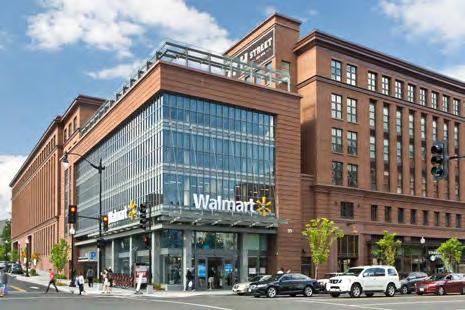
- 5941 “H” Street (+/-74,000 sf) was situated within close proximity to Union Station and next to Gonzaga High School. Basically situated on a sloped property and within a mixed use building. Walmart is one level above the main street with liner retail directly on “H” Street with 5 stories of residential above. Although the main store entrance is directly off of “H” Street, the customer is required to converse upward to enter the sales area. This supercenter was only +/- 75,000 sf with underground parking two levels below the Walmart Sales Floor. This Walmart represents Walmart’s first LEED for Retail Silver CI project in the world. Although our initial pursuit was certified we were ecstatic about achieving silver.
- 3035 Fort Totten (+/-134,000 sf) open in October 2015 is another mixed-use building. In this scenario the sales floor is directly off the street with parking directly below the sales floor and totally below grade. The parking actually had two separate entrances. Although the store is now complete and in punch list mode, we anticipate that this building will achieve LEED for Retail Certified CI and this will also represent the first LEED Certified CI project in the world. Another accolade we are extremely proud of.
- 5972 Capitol Gateway (+/-134,000 sf) is about to break ground. Similar configuration to Georgia Ave but on a sloping site exposing the lower level parking garage. This project is part of a large mixed use development. The project is anticipated to reach the Highest LEED for Retail project in the Walmart Fleet. The goal is to achieve gold. The project has been entitled, approved by the jurisdiction and we are waiting on the pad to be ready for us to start construction.
- 4304 Miami Midtown (+/-134,000 sf) will represent the largest multi-level project to date. The overall project size is roughly 550,000 sf. Construction started December 2015 and anticipated to be completed early 2017. This is a store with two levels of parking above and major liner retail along the east end of the site.
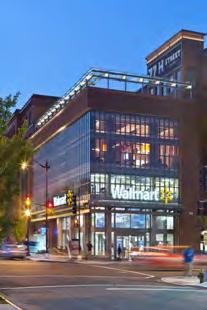

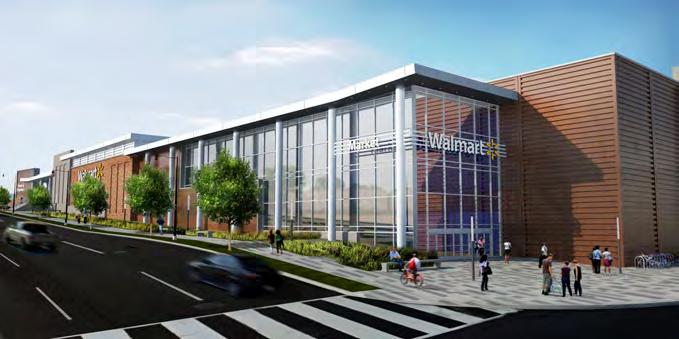
The Walmart Multi-levels come in all various sizes and configurations with common denominators. The most common denominator is that all receiving is at store level and not relying on vertical transportation methods to unload delivery trucks. On slope sites, although the stores appear to be a level above grade the receiving is not.
Type “A” is a simple structure. The store is on grade and the parking is on the roof. It is one of the least costly multi-level building types. It is more economical to reinforce the ceiling roof structure to accommodate parking than it is to dig a hole and put the parking underground. In this scenario you can still accommodate a 30’x60’ Structural Bay spacing.
Type “B” is similar to Type “A” but has 2 levels of parking above. Maintaining a 30’x60’ Structural Bay spacing is still viable for the majority of the structure, however where the residential structure is positioned the bay spacing would likely be closer to a 30’x30’ Structural Bay spacing to support all the additional loading from the structural residential or corporate layers above the primary decks.
Type “C” is also similar to Type “A” but has parking below grade as well as on the roof. Although digging to provide parking below grade is more expensive alternative for parking, there are instances where you may want to dig rather than elevate. These conditions could be a result of demolition of an existing structure that creates a crater type condition or a site which may have poor soils that need to be removed.
Type “D” is a structure type more commonly found in dense urban areas where the store truly falls within a mixed-use building with multiple levels of residential or office spaces of the store level. In this scenarios the store’s parking level may be found 2 levels below the store sales area. In these more complex structures a 30’x30’ Structural Bay spacing to support the structure above the store levels are usually incorporated. This type of structure is commonly referred to a podium with stick. The podium is usually constructed of concrete to attain the required fire rating while the stick refers to wood construction similar to the construction of residential properties. In certain scenarios metals studs are used or integrated with the wood structures. In this scenario the entire store including the stores ceiling is all concrete while everything above would be wood.
Type “E” is often referred to a proto on stilts. This is probably the most economical multi-level store to build. Often found on tight site with little acreage to accommodate the parking needs to facilitate the operation of a store. This store type allows you to maintain prototypical features such as rooftop HVAC and refrigeration systems, lighting and so on. You may also be able to avoid a parking garage exhaust and ventilation system if there is sufficient exposure to the exterior along the garage facades. It will also allow you to maintain a 30’x60’ Structural Bay spacing as the supercenter prototype currently has. Another reason to elevate to the structure is to accommodate deliveries as indicated in this illustration. The more economical solution is when you are carving into a hill with the backside towards the carve-out, this will avoid the need to build a bulkhead to get the receiving trucks to the loading dock. On site that are relatively flat you will need to build a bulkhead to accommodate a roadway about 10’ high to get to the receiving level. In these type of scenarios we revise the proto receiving area to have all loading on one side to minimize raised loop roadway (bulkhead) around the entire rear of the building.
Type “F” is very similar to Type “E” and Type “C”. Sloping sites in certain situations really help in developing excellent stores. It allows the deliveries to be maintained directly to the main level of the store but also allows the opportunity to add liner retail with smaller shops directly below the store level with frontage on the main boulevard or simply have parking at grade while simultaneously providing roof deck parking.












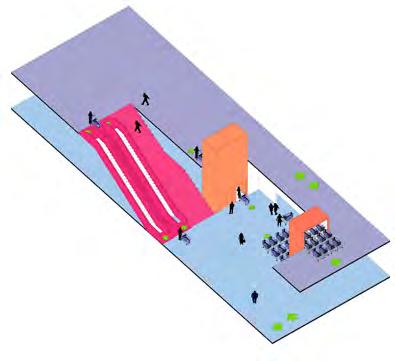
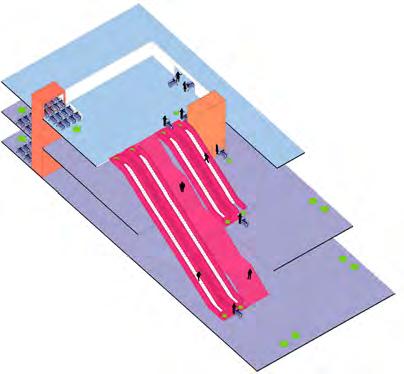
The illustrations above are not for the purposes of suggesting possible layouts or configurations of vestibules. This will be discussed in case studies further into this narrative. These illustrations are nothing more than a simple exhibit outlining the components necessary to move customers and carts.
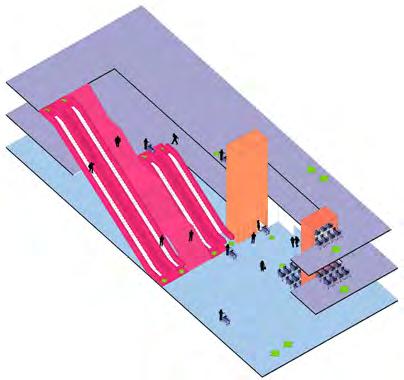
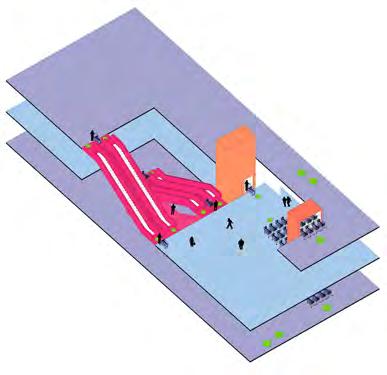


Vertical transportation “is everything” in a multi-level store. Not only are you required to move customers vertically, you are required to move them vertically, quickly! Depending the configurations of the floor plates it will help you determine what components you will need.
Grocery stores are unlike department stores and should be considered different. Usually in a grocery store shopping crats are used while in department stores either small baskets or your hands and arms are you utilized. Therefore, in a multi-level department store you can de-access escalators at any given time and re-access to work yourself to higher levels. Basically stacking the escalators just like you would with stairs accessing multiple stores. Staking one over the other.
However, in a grocery store that does not work as effectively or efficiently. Imagine trying to disengage from an escalator to have to wrap around and re-engage again to get the next level with a loaded grocery cart. Complicated, right! In this scenario you would most likely avoid the escalator on your next attempt and just wait for an elevator.
It’s important to note that ideally it would be great to have redundancies in vertical transportation systems as well to accommodate system failures, especially during peak hours. However, redundancy not only costs extremely more for something that may never be used but more importantly multi-levels are usually found in urban areas where real estate costs are considerably higher in cost per square foot. Every square foot not dedicated to sales area is an additional out-of-pocket expense. Later in this guide we will discuss the balancing of the floor plan.
Escalators move approximately +/- 3000 passengers an hour while hydraulic elevators move about +/- 450 passengers an hour and traction elevators about +/- 600 passenger an hour. The first exercise in developing a multi-level is to determine the primary mode of vertical transportation. Although, we have seen Walmart’s competitors use elevators as a primary source, it has been a major challenge for Walmart to be able to utilize them due to the number of customers they are required to move per hour. We only have one multi-level store to date that utilizes elevators as a primary source and that was due to numerous mitigating factors from limited floor space to numerous levels to access.
Escalators continue to prove to be the best mode of vertical transportation available. Ideally three escalators would be ideal but is cost prohibitive and occupies too much space resulting in oversized vestibules. In addition to each up and down escalator, a cartveyor is required. In addition, 2 to 3 passenger elevators are required to accommodate the seniors and physically challenged. A Cart Lift is also required for restacking carts collected from the various garage levels to the sales floor.
Therefore when you have multiple levels to reach, we recommend that direct access from the main sales area to that parking level be provided. Therefore is you have a simple two level store (sales + parking garage) the ideal components needed would be as follows:
1. Two escalators (one up and one down)
2. One cartveyor situated adjacent to the escalator in the direction of customers exiting the store and headed towards the parking area.
3. Pass-through elevators to accommodate seniors and physically challenged or for customer convenience
4. A Cart lift to transport carts from the garage level to the sales floor.
5. Convenience stair in case of a malfunctions of a vertical transportation component or simply for customers that prefer it over motorized equipment.
Hydraulic elevators verses traction escalators. Putting aside cost and speed for a moment, the most important factor in determining which of these elevators are more suited or applicable to your design condition,you will need to consider floor to ceiling heights. Although in general, the Walmart sales area in a multi-level condition is anywhere from 17’-20’ allowing sufficient override space. However when a mezzanine that requires accessibility access comes into play, then a 20’ overall floor to ceiling height may be come insufficient and thus impacting the floor plate above and thus impacting the tenant above. Another scenario to be concerned with when considering traction elevators are overrides and how they are impacted by zoning building height restrictions. In certain zoning ordinances bulkheads may be considered height to a structure preventing you from using traction elevators in your design.
In general, some of the pros and cons are as follows;
1. Hydraulic elevators are less expensive but move slower.
2. Traction elevators are more expensive but move passengers quicker.
3. Traction elevators need much more override space than hydraulic
4. There are certain traction elevators that provide less override than the typical competitive marketed elevators. However, this will result in hire initial cost as well installation costs and become more proprietary and less competitive.
5. Hydraulic elevators require a machine room adjacent to the elevator bank. Although the elevator machine room is adjacent to the elevator banks on the main floor, they can also be placed a floor above to minimize the impact on the sales area.
6. Traction elevators don’t require machine rooms, everything is in the override space.
When it comes to the cartveyor there are two schools of thought. The decision maker (the client’s internal delegated multi-level leader) will make the final call. In visiting a multilevel store, many times you will find the cartveyor is sandwiched between the up and down escalators. The benefit of this arrangements allows the store to reverse an escalator if the other fails and goes down while minting the same proximity to the cart on the down or upward travel of the customer.
The other school of thought suggests that the cart be positioned to the extreme left or right side of the escalators and not sandwiched between them. The reason this alternative may be considered it that theft of merchandize is minimized from passengers on the opposite escalator having the same distance to the cart. The perception is the passenger on the opposing escalator can easily extend their arm over the escalator rail and possibly steal merchandize or even a purse from the cart without the customer even acknowledging, especially if there head is turned in the opposite direction. To overcome this theft the escalator manufacturers can provide a Plexiglas guard to place on the escalator.
We feel there are four levels of service that a multi-level mode of vertical transportation falls within. Within the 4 Categories you can easily add a plus or minus symbol based on the efficiency of the layout and components. The grade level indicates if the required equipment has been met while the layout helps to improve the correlation between components and the customer. (i.e. if for example the layout somehow impedes the flow of traffic within the vestibule (via pedestrian cross patterns) then a minus (-) would be provided due to the negative impact the layout has. If the layout and configurations enhances the customer experience then a positive (+) is utilized. It is very important to note that the goal is always to pursue a Level “A” without question. However that being said, we have used a level “C” where there are numerous outweighing factors for example, high profile areas, extremely high volume stores and when no other level can be achieved due to the limited floor space available.
It was decided that the primary mode of vertical transportation for “H” Street would be 3 “True Pass Through Hydraulic Elevators”. Due to the 20’ ceiling height, traction elevators were out of the question due to the override requirements. All three elevators service the garage level, the lobby street level and the upper level sales/grocery floor. In addition, one of the 3 elevators also extend to access the mezzanine level. Due to the 20’ clear ceiling height the one elevator bank servicing the mezzanine actually extended through the ceiling and impacted the residential apartments above. This is why it is imperative when mezzanines are incorporated that 22’-24’ clear height be provided.
This store did not include escalators directly to the parking garage for many reasons. The primary reason is that the original design initially had 2 levels of parking below grade and without direct access to each level, escalators to those levels were out of the question. However, that being said we did provide escalators and a convenience stair from the sales floor to the street level for customers entering the store from the sidewalk level. A cartveyor was excluded since cart access is only limited to parking garage levels and we wanted to avoid carts piling up in the lobby level. The last thing the store needed carts impacting a very confined lobby

Out of all the multi-level stores we had developed this store probably has the lowest level of service in regards to vertical transportation. There are numerous reasons why, and these include the simple fact that no escalators directly to the garage. No cart lift to move carts from the garage level back to the sales floor (the elevators are used to handle this function) and lastly there was confusions on how priority of the sequencing of the elevators door opening and closing on specific levels. We have since corrected our controls from lessons learned and we are process of adding a cart lift to the store to avoid using service elevators to transports the carts from the garage back to the main level. These accommodations will greatly improve the efficiency of the vertical transportation.
It was decided that the primary mode of vertical transportation for “Georgia Ave” would be 2 escalators, One cartveyor sandwiched between the escalators, 2 nonpass through elevators to accommodate seniors and physically challenged and/or for customer convenience, 1 cart lift to transport carts from the garage level to the sales floor and one convenience stair in case of a malfunctions of a vertical transportation component or simply for customers that prefer it over motorized equipment. The layout for Georgia Ave had many advantages over “H” Street store. The vertical transportation for this multi-level only had to contend with two levels. Although this store also contained a small mezzanine it was decided that a small handicap elevator would be provided to access the mezzanine area from the back of the house on the main sales floor. The mezzanine was also remote from the main elevator bank and it proved to be a more economical approach to incorporate this small independent elevator.
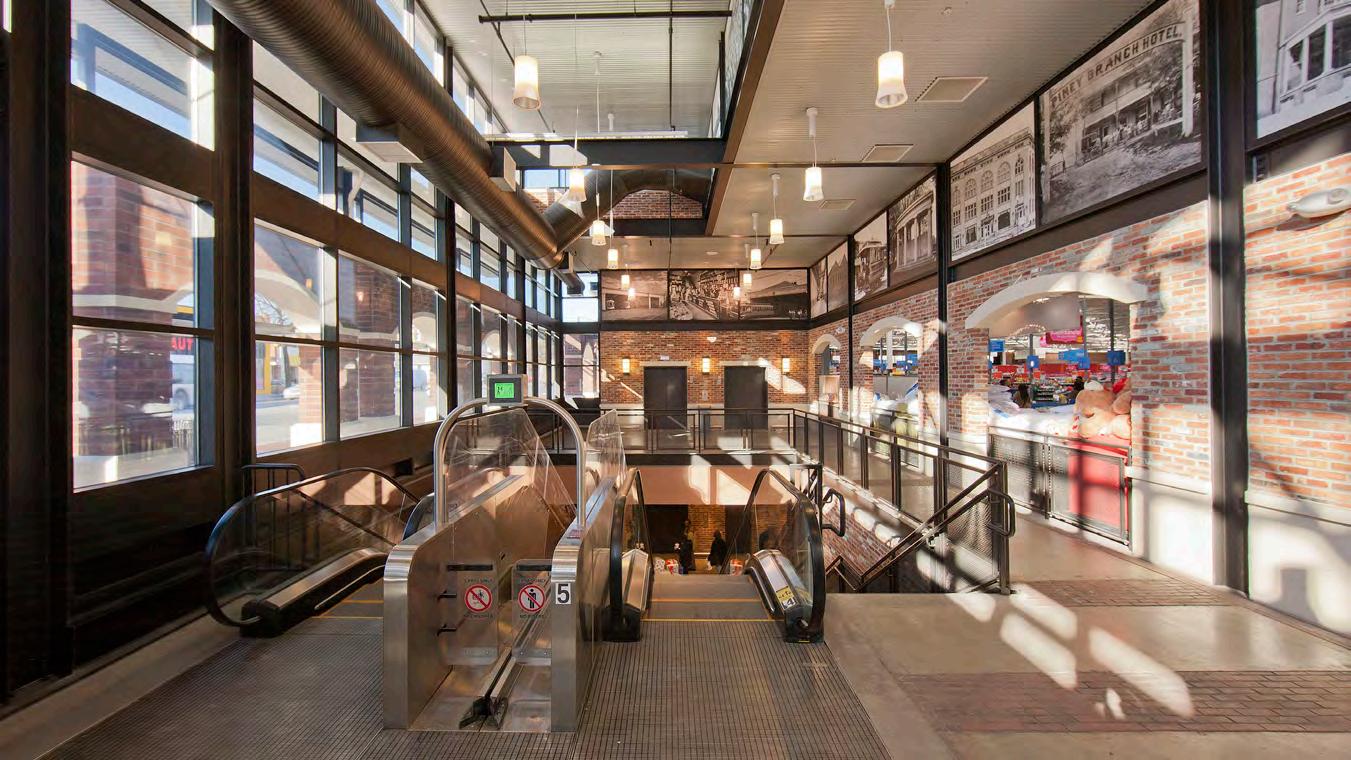
The multi-level scenario for this store is considerably better than “H” street. Considering the direct access with the escalators to and from the garage, operationally the vertical transportation works well. The only attribute keeping this store from being the highest level of vertical transportation efficiency and service is the fact that the elevators were “not” true pass through, meaning that you would have to enter the elevator by pushing your cart into the elevator and then backing out with your cart when exiting the elevator. Considering that elevators are only minimally used, the impact to the store is minimal.
One of the lessons we learned from this scenario, is that the space below the escalators has tremendous heat buildup due to being a confined space. Although best practices was used in designing the cooling requirements for that confined space we have since recommended increasing the cooling requirements to improve on the safety factor to minimize any further heat build-up.
It was decided that the primary mode of vertical transportation for “Fort Totten” would be 2 escalators, one cartveyor sandwiched between the escalators, 2 pass through elevators to accommodate seniors and physically challenged and/or for customer convenience, 1 cart lift to transport carts from the garage level to the sales floor. However unlike Georgia Ave there was insufficient space for a convenience stair. Not having a convenience stair is certainly a negative. On the other hand, the elevators were situated in a fashion to push your cart forward and also to push your cart forward to exit without having to worry about backing yourself up when exiting the elevator. The layout for Fort Totten had many advantages over “H” Street store as well. The vertical transportation for this multi-level only had to contend with 2 levels. Although this store also contained a small mezzanine it was positioned in a fashion that allowed one of the main elevators to extend to that level which was certainly a plus. In addition, the floor to ceiling height was greater in this store than “H” Street allowing the elevator override to be contained within the Walmart envelope without having to worry about penetrating and or impacting floor levels above.
The multi-level scenario for this store is also considerably better than “H” street. Considering the direct access with the escalators to and from the garage and the connectivity of the elevator banks with all levels including the mezzanine and the ability to push forward while entering and exiting the elevators makes operation of the vertical transportation works well. The only attribute keeping this store from being the highest level of vertical transportation efficiency and service is the fact that the elevators are “not” true pass through, and the missing convenience stair. Normally this layout may have been categorized as a “B-“the layout of the vestibule more than increases the efficiency due to its layout. It was able to minimize cross traffic of customers. Customers exiting from the registers had very minimal impact from customers entering the store and therefore this raised the grade to a “B+” and deservedly so.

One of the lessons we learned from this scenario is that every effort should be made to implement a convenience stair. Although there may be mitigating factors preventing you from doing so, it strongly recommended that you don’t give up easily on this decision. Long after the store is open, the operators will always wonder why it is missing and rightly so. Successful stores are all about convenience.
This store represents the biggest Multi-level MMA has worked on to date. This store not only includes about 150,000 sf of floor area it also includes 2 levels of parking above, plus it also includes a liner retail track on the opposite end of the building. The overall square footage of this entire building exceeds well over ½ million square feet. This is another project that MMA took over from the original designers. I believe the decision in part, was due to the success we already achieved from the other multi-levels but more importantly we had already reached the stage or better yet earned the respect to spearhead the finalization of the design. In evaluating the existing design we realized that the escalators were stacked requiring you to engage and disengage as you worked your way through the various store levels. The parking layout were basket weaved basically orienting parking stalls in different directions on each floor level. Elevators were not pass through and convenience stair was enclosed. The structural column spacing was not oriented in the sales floor’s best interest or parking deck’s best interest. These failures or inadequacies were not due to poor designers, but due to familiarity with how Multi-levels work. In the end, if the original designers had more time and expanded their team to include parking consultants, vertical transportation consultants and so on, they may have actually reached the same conclusions that we reached in our final design. It is important to note that the consultants you retain may not be thoroughly familiar with the Client and that is why you have to constantly question their design decisions and continue to educate them on how the store operationally works. Just because you retain an expert in a field does not mean that you will get something that works. Knowing the client is what makes projects successful.
Since this store has 2 levels of parking above the main sales floor on the ground, a total of 4 escalators were required. Unlike the traditional staking of interrupting escalators, each bank of 2 escalators extended from the ground sales floor directly to the specific parking deck. A straight run. Adjacent to each escalator bank was a cartveyor that also directly extend from the sales floor to the specific parking level. In addition, to the escalators we incorporated 3 “true pass through elevators”. In lieu of utilizing hydraulic we utilized traction elevators. The hydraulic elevators were in sufficient in speed to move the number of required customers during exiting the store. Furthermore, an open convenience staircase was provided for customers to have easy access to all levels. This store has all the components and layout that makes it a Level “A+” experience. This store is anticipated to move a tremendous amount of customers especially during holidays and peak hours.
Having 2 escalator banks accessible from the sales floor required clearly marked directional signage to avoid customers from getting on the wrong escalators and ending on the wrong level of parking when leaving the store. Way finding signage plays a major role in a multi-level stores.
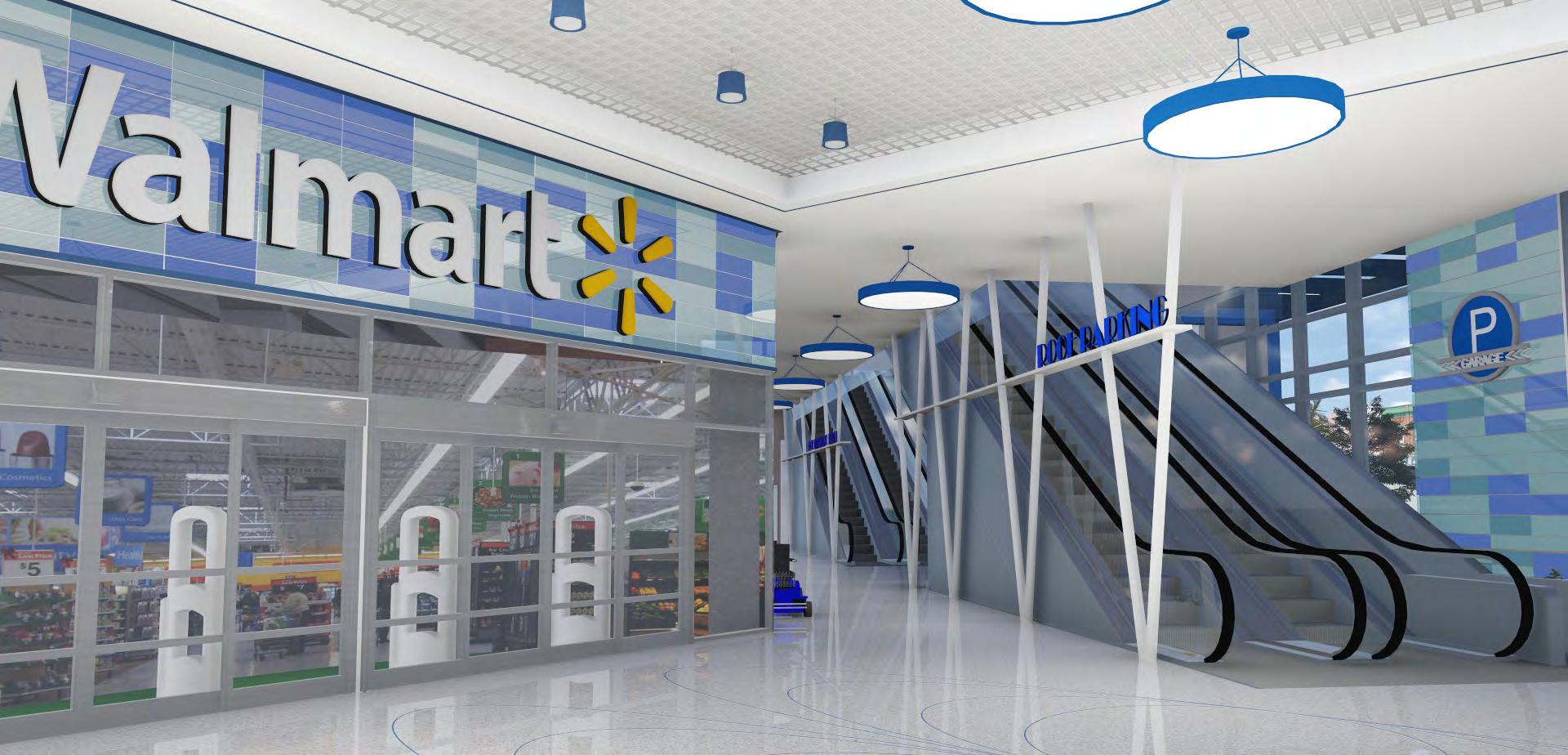

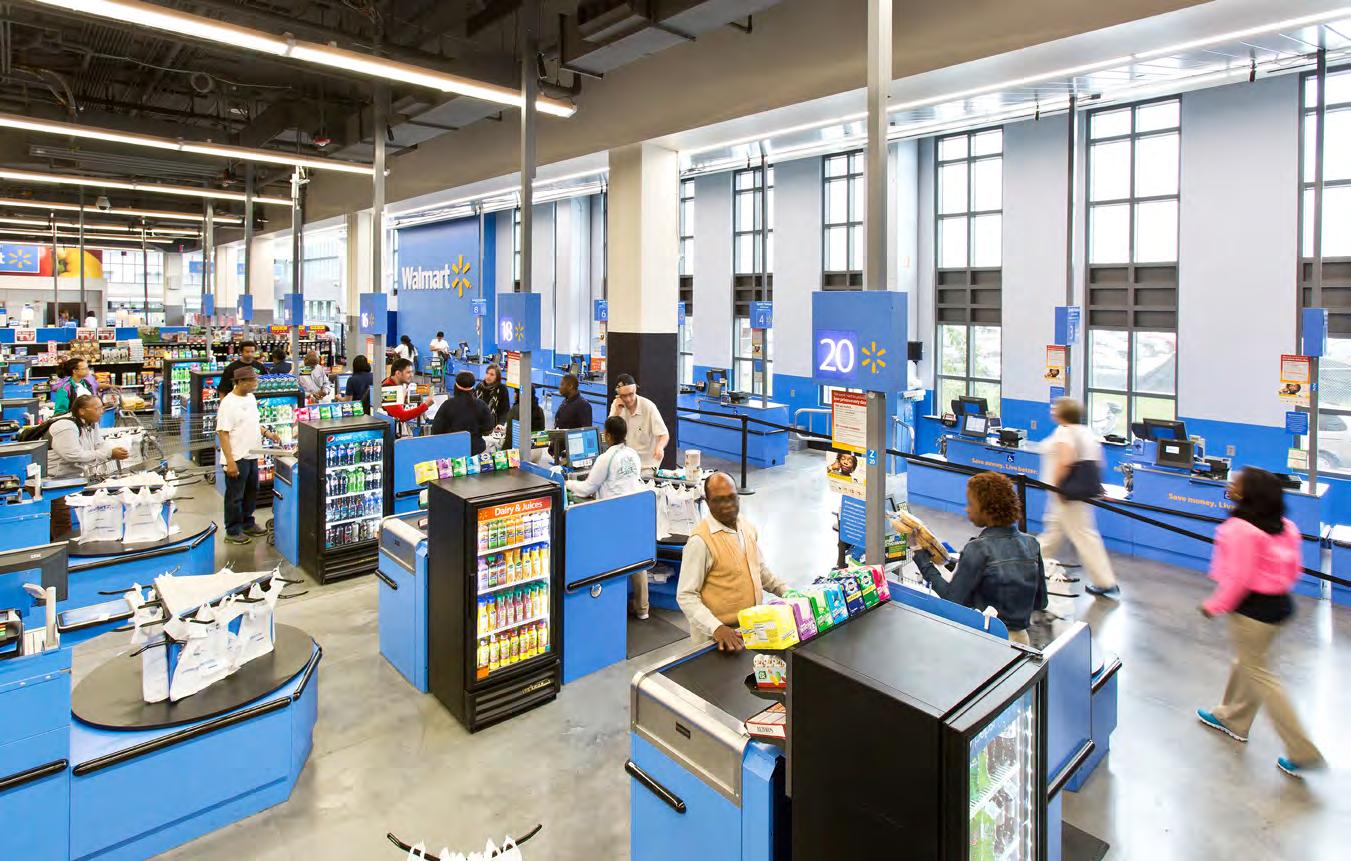
Multi-levels as previously stated come in a variety of shapes and sizes. In addition to various shapes and sizes, the sales floors are above or below the parking superstructures. Our early design concepts resulted in excellent vertical transportation flow configurations and redundancy in components. However, what we were beginning to realize was that the oversized vestibules were taking away from what was the most important aspect of any store, and that is the sales floor. Sales is what really drives the success of any grocery store, in fact, any store at all!
Any designer engaging in a multi-level exercise needs to begin to find a balance between functions. In the grocery industry, it is safe to assume that form does follow function. The “H” Street store is an excellent example of how we accommodated a supercenter in a very dense urban environment and did it in a +/- 84,000 sf footprint. In the era of early 1990’s a Walmart Supercenter reached areas well above 230,000 sf. Even today, the supercenter proto ranges from 151,000 to 180,000. “H” street is nearly half the standard proto coupled with 4 floor levels to contend with.
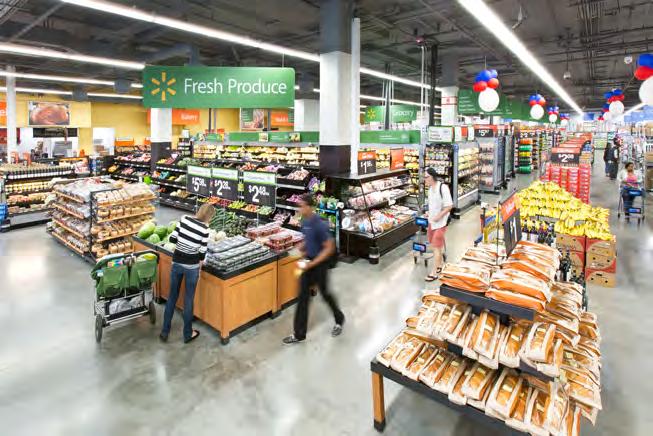
So you may ask yourself, how did we accomplish that? Collaboration, team work, skilled and creative individuals from the design team to the Walmart Stakeholders. Although the architect is often commended after the store is built and opened, however there are so many individuals that contributed to that success of a multi-level store and may never be recognized for it, until now. The Walmart Design Managers and Real Estate Team along with the Site Adapt Architects, The LEED Specialists, Operations, Merchandizing and the list goes on and on. There are civil engineers, MEPR engineers, structural engineers, controls support staff, security and the list still continues. There are too many individuals to enumerate.

The architect that spearheads this exercise needs to recognize that his/her overall goal is figure out how to best capitalize on those talents, orchestrate the assembly the various aspects of these very sophisticated components and how to pull it together in an extremely tight timeline without to many failures. Time is money! I have yet to be assigned multi-level exercise with an abundance of spare time associated with it. They move extremely quickly and Charretting does wonders!
Developing the initial concept is very telling. Aside from the obvious “the footprint size”, begin to quickly analyze the various heights you will be contending with, the structural bay spacing and how that impacts the various levels of parking above or below. Determine how you will condition the space, how customers will want to access the store and most importantly how you can implement a Vertical Transportation Level “A” service within the store. Also begin to think about the delivery fleet and how you will segregate that from the customers. Lastly in multi-level, make sure that you thoroughly understand the impacts of all the infrastructure penetrating the store ceiling from all the development above to ensure that appropriate zones for each lessee is maintained and you can safely and easily integrate your infrastructure without impact the required store ceiling clearances. If at the end of this exercise you have developed a concept that address all these issues, maintains nice store exposures, meets the necessary parking ratios, the project is likely to move to the next level of design and or discussion with the Walmart Stakeholders. Experience verses inexperience designers developing multi-level concepts. The above is just the tip of the iceberg. If you are unfamiliar with parking garage analysis for example and way finding you will need to bring on a parking consultant to help you and that begins to delay the process. The same goes for the understanding on how vertical transportation works. Vertical store design resume is much different than horizontal store design. Get yourself familiar how ramps works, what are the required slopes, what are transitions, when do I implement controls, when do I charge to park. Hopefully this exhibit begins to give you a better understanding on how to best prepare yourself in developing a successful multi-level design.
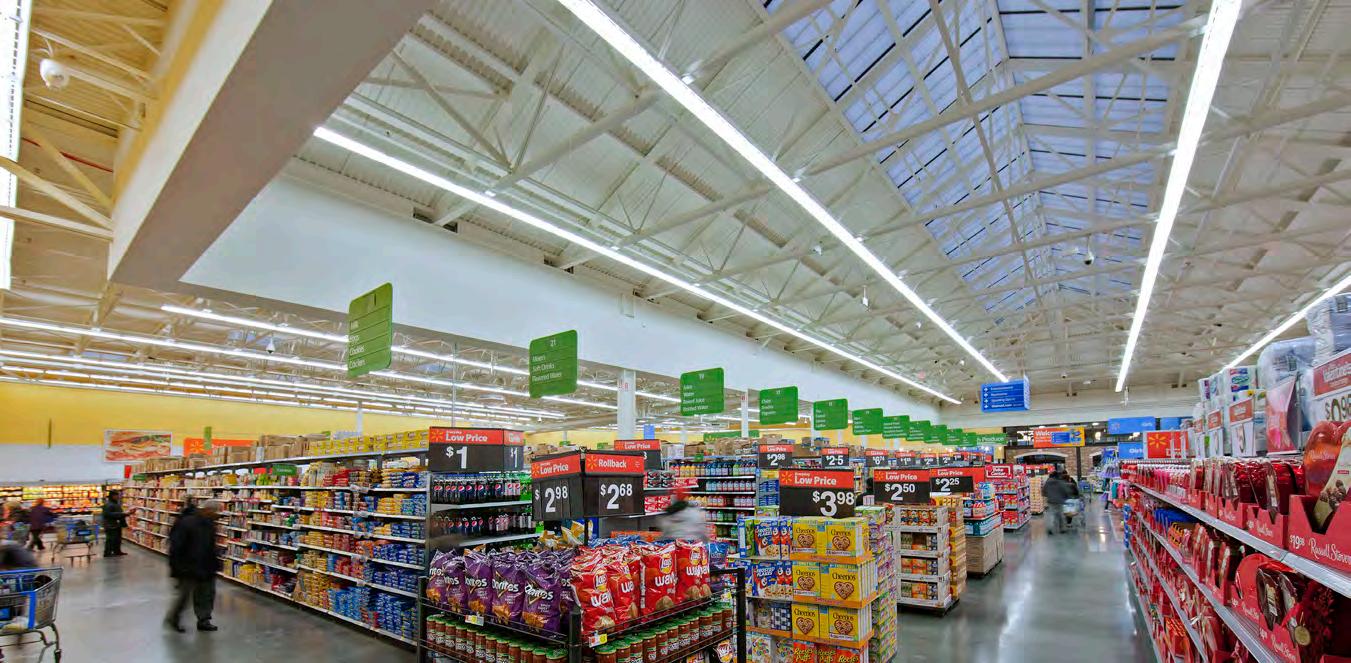
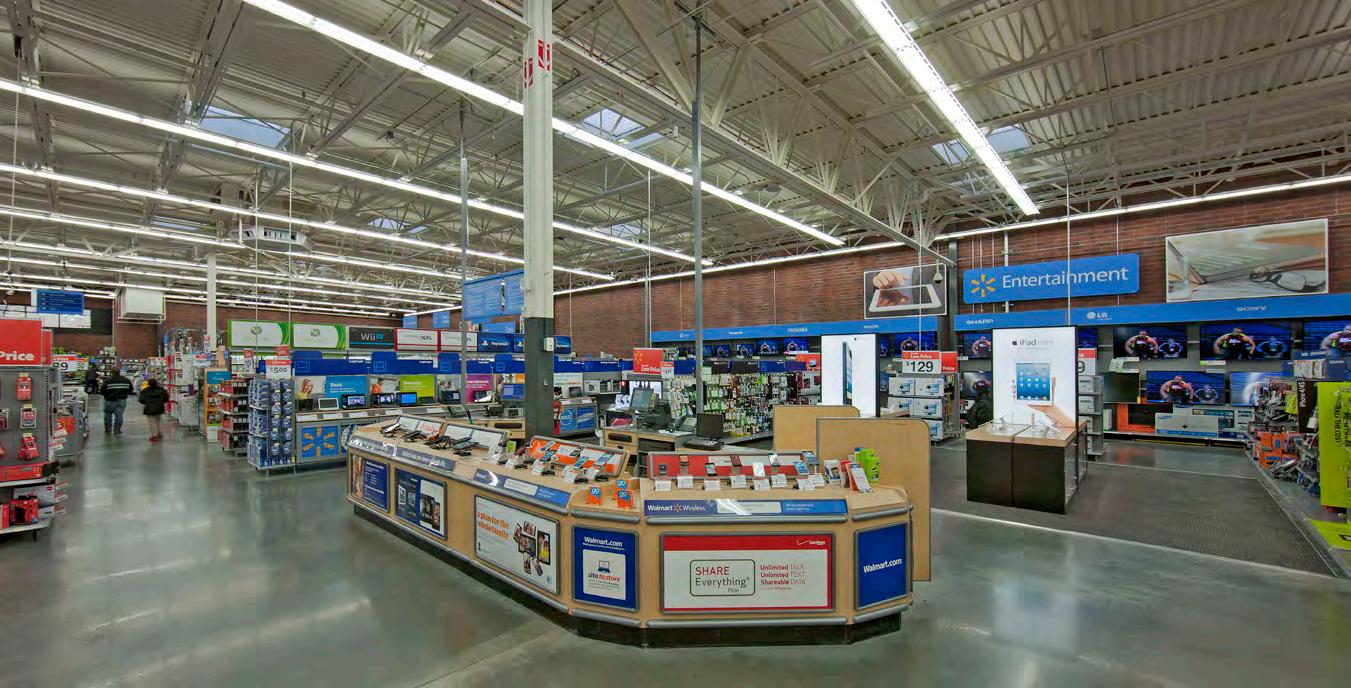
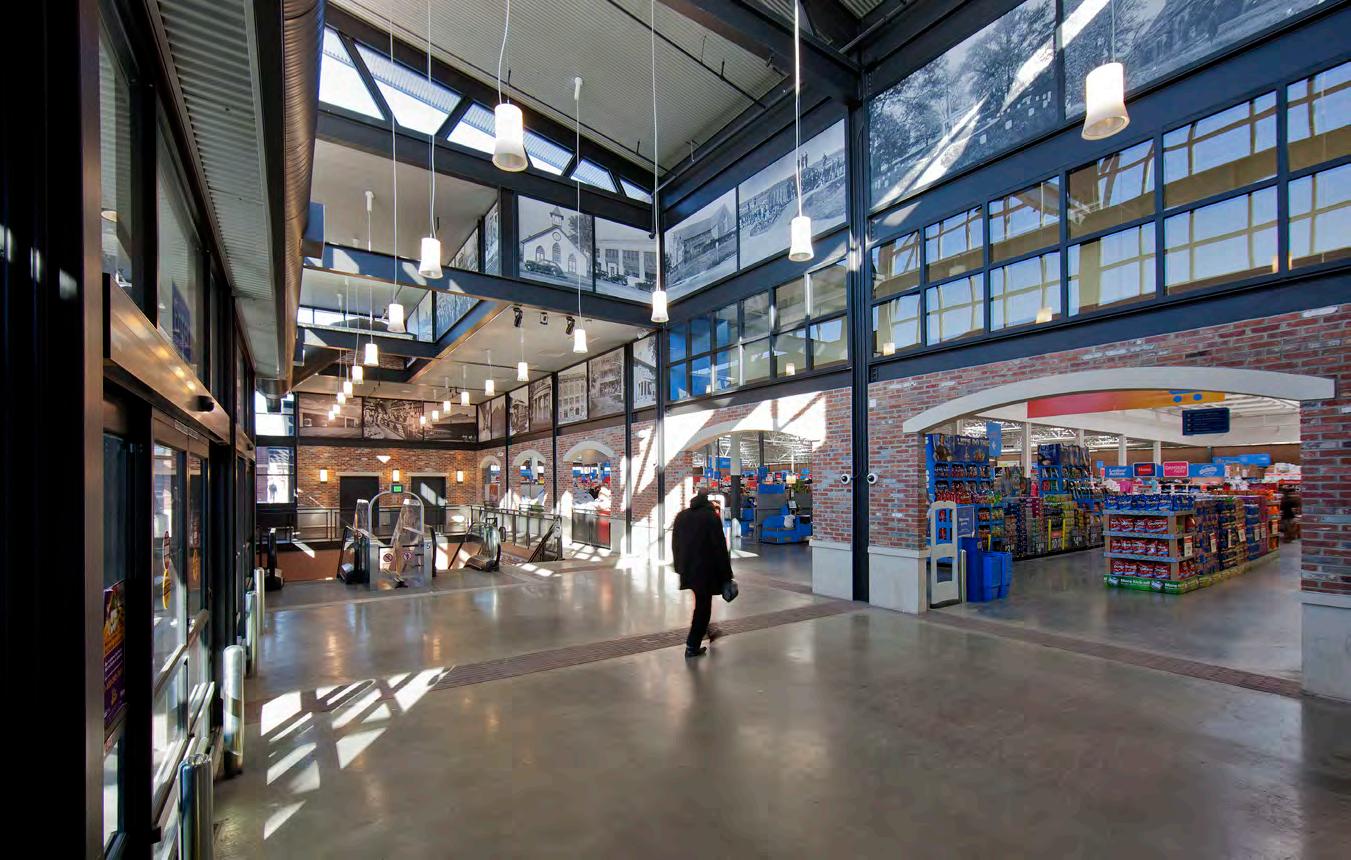


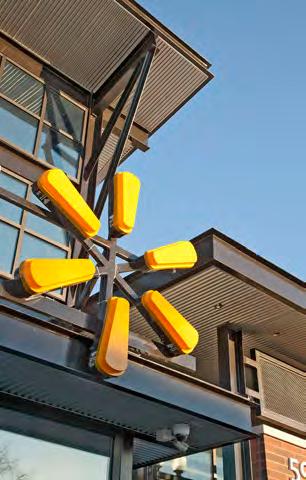
The primary objective of parking lot design is to provide safe, efficient vehicular access to parking stalls that serve the store. Unfortunately, all too often, the important functions of the new store’s parking area are overlooked. Not only is the parking area the first part of a building complex seen by the user, it is the gateway through which all customers pass. This first impression is quite important to the overall feeling and atmosphere conveyed by the new store and should be treated as such. When properly designed and constructed, parking areas can be attractive, safe, and above all, easily and efficiently usable. In addition, they should be designed for low maintenance costs.
Walmart prototypical stall sizes are customarily 10’ wide by 20’ deep with drive aisle that are usually 24’ wide between stalls and usually 30’ wide loop road that pass the front doors. This is pretty typical for retail architecture. Again, it is all about customer convenience and experience. Unfortunately when parking areas are placed in a garages or confined area in urban environment it is unlikely that those spatial requirements can easily be met. Individuals living in urban environments have come adjust themselves to much more confined environments. Ramps are steeper, drive aisles are narrower, spaces smaller and circulation cumbersome.
Usually in urban environments in residential or office building the structural columns are usually arranged in a 30’x30’ bay spacing and sometimes smaller. Although in this type of structural configuration parking stalls for those uses can work. However, it is not very well suited for retail use. In residential and office environments, once the car is parked it is unlikely it will be used infrequently. Whereas in a grocery store environment customers are coming and going regularly all day long. Therefore, multi-level parking garages needs to have a very good level of service associated with it. Just like traffic studies have levels of service associated with them, so do parking garages.
A typical prototype Walmart has a 60’ structural bay spacing. This translates into an excellent configuration for the lower or upper parking levels as well. In situations where a multi-level is on stilts the column bay spacing down the drive aisles can be maintained at 60’ wide but in the opposite direction the span can be reduced to 30’ on center as a value engineering measure since it does not impact the drive aisle width or the efficiency of the stalls and still allows the typical 60’ bay spacing in both directions on the upper floors.

Maintaining a 60’ width allows for 18’ deep parking stalls with a 22’ wide drive aisle, and in in an urban environment, is excellent. Also to improve the parking ratio, 9’ wide stalls are utilized in lieu of 10’. That basically translates into one additional car stall every 10 spaces in alignment.
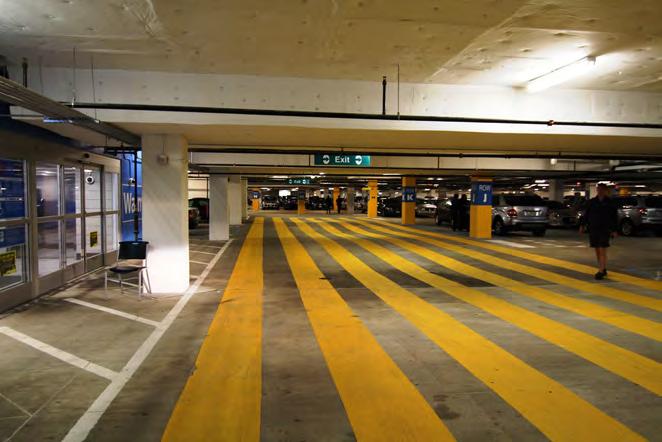
Also the 60’ bay spacing easily allows for 30’ main loop drive aisles, especially as you approach the vestibule. Parking stalls are position perpendicular to the front wall. There are many reasons for this, but the most obvious, it is the safest and fastest customer approach to the front doors.
Customers park in a form of a football around the store entrance. These are the closest spaces to the door and are usually the first occupied spaces. In a multi-level the handicap spaces are the closest and rightly so. The same goes for car/van pooling. More and more, electric cars are being utilized in urban environments and we are beginning to incorporate charging stations into garage design. These spaces are usually situated further away from the entrance since they only make up an extremely low percentage of customers. We have found situating them close to the entrance of the garage begins to share with customers the Walmart Sustainable story without taking away prime real estate.
Garage ramps play a major role in the efficiency of garage. This is where we find the inexperience when it comes to taking over projects from other designers. The ramps are always to steep, missing transition strips and positioned improperly. Similar to parking layout and efficiency, there is a difference when it comes to retail in comparison to many small garages typically found in an urban environment with double digit percentage climbs. Garages heights in residential and office buildings usually have low ceilings buin Walmart stores we attempt to maintain 10’-12’ clear. Otherwise the expansiveness of the garage feels compressed and unwelcoming.
A 5% ramp slope with 2.5% transitions are ideal for our multi-level garages but become extremely length and expensive and takes away from the space needed for the stalls. This slope is the safest and allows you see the top of the ramp when you engage on your climb to the upper level or descend to the lower level. We often find that our ramps fall within the range of 8-10%. There are times when we have to utilize 12% but we avoid that at all costs. A 5% ramp slope with 2.5% transitions are ideal for our multi-level garages but become extremely length and expensive and takes away from the space needed for the stalls. This slope is the safest and allows you see the top of the ramp when you engage on your climb to the upper level or descend to the lower level. We often find that our ramps fall within the range of 8-10%. There are times when we have to utilize 12% but we avoid that at all costs.

There all different age groups, different skill levels of drivers, drivers comfort z ones, etc., and it is important to design something that addresses the majority of the age demographics of the customers. If customers become uncomfortable in climbing ramps they won’t come back.
When it comes to lighting a garage it is extremely important that it is very well lite. We over illuminate the main vestibule area to quickly help identify its locations. Customer’s need to feel safe. In all our garages we have incorporated LED lighting. The light is so much brighter, let’s off less heat and has such a tremendous life cycle.

In addition, we have added aisle markers to help customers recall where they have parked prior to entering the store. Also to help easily identify the location of the vestibules, are main drive aisle structural columns are now painted yellow while all other columns are painted white with blue bases. All emergency call buttons are painted blue while all fire alarm pull stations and fire extinguishers column locations are painted red. This helps everyone quickly identify their safe zones and obviously their familiarity with those functions.
Garage ventilation also plays a major role in the design. Obviously in fully enclosed garages mechanical ventilation is a requirement. In partially enclosed garages the determination will be based on the amount of fresh air the garage is exposed too. Usually a building on stills with all 4 sides of the building open does not require mechanical ventilation. Nevertheless, it is important in your initial analysis to determine if one is required, where it will be positioned and how it will be exhausted and how the fresh air will be captured. This will add a considerable up cost to the project and the Walmart estimators will want to know this since it adds to the bottom line.
Lastly in retail environments, customers are not designed to park their vehicles on slopes. It is not only very inefficient and inappropriate especially when it comes to the utilization of carts.
As part of Walmart sustainability, saving energy is imperative. That being said, our LED garage lighting was initially designed in our first DC multi-level to be zoned therefore allowing the lights to dim when no movement existed. That led to the appearance of slightly darker garage appearances so we eliminated that function to help maintain a brighter environment.
Also in the hot summer months the enclosed garages tend to get warm so we incorporated thermostats throughout the garage to help signal the ventilation system to turn on sooner to help air circulation in the garage. It helps keep the garage much cooler





You may ask yourself, why parking controls? Does Walmart want to charge its customers to park? The answer to that question is obviously “NO” is does not correlate to everyday low price (EDLP). Although, we install the infrastructure in our urban formats, it is rarely implemented. Sometimes only the gates.Where parking controls may come into play is when the store is located near a major transit hub. In these scenarios many non-customers begin to utilize the spaces at no cost and take away spaces from the needed customers. In these scenarios controls will be incorporated and shoppers will get there ticket stamped to allow them to exit without paying. Controls in a Walmart Multi-level are really there to deter the non-customers from utilizing the parking spaces. In many urban areas in the northern states when inclement weather approaches such as snow storms non-customers also tend to want to park in the garage.
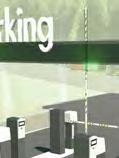




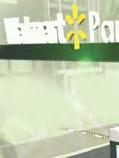























When it comes to purchasing and implementing parking control equipment it is important to note that technologies is changing so quickly and within 6 months to a year parking control technology is updated. So when you need to implement specific equipment timing is everything.
















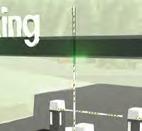
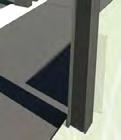


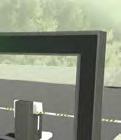
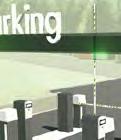

The mechanical system in a multi-level store is the most heavily coordinated aspect of a new store. When designing a system there are many different parties that play an important role in the type system and units that will be specified. Key contributors are Mechanical design professionals, Walmart unit suppliers, Walmart control vendors, Walmart team members, and the contractor and mechanical subcontractor.






On a proto-typical Walmart the mechanical units are installed directly on the roof. These are complete packaged air handling units spread throughout that distribute air directly to space below. In the sales area the air is discharged directly from the bottom of the unit with no duct runs. Smaller rooms are connected with standard supply and return duct system. The proto-typical mechanical system can be applied to several of the multi-level typologies when there is no building or parking above. It was successfully designed and installed at the “Georgia Ave” location and the designed at the “Capitol Gateway”. This system proves to be the most economical to install and minimizes the opportunity for error since all suppliers and vendors are familiar with the system.

The complexities begin when the multi-level site introduces parking above, or the sales space is located within a mixed-use building that may have several levels of residential above. At this point you need elevate the type of system that will work best for the store. If possible installing air handling units in a forced air is the preferred method on distribution. When a store has a single level of parking above, roof parking, it is possible to use the air handling units similar to a prototype. On these types of stores you will coordinate several locations on the roof to group the mechanical units. The units will penetrated through roof, but unlike the prototype, all air will need to be supplied by throughout the entire store with supply and return ducts. This often creates longer duct runs and you have to pay particular attention to ceiling heights due to the large size of the ducts.When you can no longer create space for air handling units then you need to move away from a forced air system and transition into a piped system. In a piped system you will need a central location to place chillers and pump systems. This can be located directly above the store level when you have parking on top or in the case of a mixed-use building, it can be located remotely several floors above the store level. Within the store space is located small DX type units that locally distribute the air throughout space. Hot or cold water is sent though piping system to DX unit where air is blown over the coil. When designing a spilt system it important to plan for space along the exterior walls for louvers. Each DX will require fresh air that is connected by ducts to exterior wall. This is the most complicated and costly system for Walmart to install. With this type of system the design is completely customized and you are not able to use any of the design efficiencies that are used in the proto. The pipe system will require advance controls because now the units in the store need work as one complete unit rather than several individual units.
The basic scenarios provided above can be broken down into 3 levels of services; Level “A+/-” Exceptional – Anytime you can located the units on the roof directly above the store. Prototypical units spread throughout the roof area, and is familiar to Walmart and all vendors.
Level “B+/-” Above Satisfactory – Air handling units grouped and located in designated areas about the store. Units are similar to proto-type and familiar to Walmart and vendors. Large duct sizes and long duct runs results in more coordination and loss in system efficiency.
Level “C+/-” Acceptable – A fully piped system with DX units in store space and remote chiller. This systems allows you to operate within building with multiple level above. Pipe systems often are more efficient than a force air system over time. Upfront cost and design coordination is very complicated, and it’s not as familiar to Walmart and their vendors.
The biggest lesson learned on the mechanical system occurred on the “H St” in Washington, DC. This project is located in a densely urban area and part of a larger mixed use building. Above the Walmart store level is 5 stories of residential units. On this project we went with a fully piped system with the chiller located on the roof 5 stories above. During the design of the system there was little input from the Walmart control vendor. Typically there is none required and the vendor comes in after unit installation to install the control system. This is a supplier that is contracted directly by Walmart, and not part of the design team. After the units and mechanical system were installed on this site there was a lot of complication getting the system to operate correctly with the controls. Since this is a continuous pipe system everything needs to communicate and sync holistically. Many valves and sensors need to be replaced and added in order to get the entire to system operate in harmony. This caused delays in operation and additional cost to Walmart. In the future it is important on a system of this complexity that all parties be involved from project initiation including manufacturers and vendors.
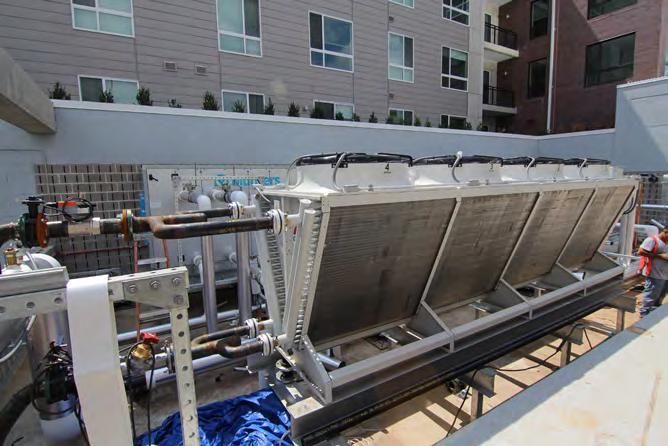

A prototypical Walmart has steel columns, bar joists, metal decking with slab on grade. Can’t get simpler than that. It is a proven formula and Walmart procures all the steel for their projects directly.
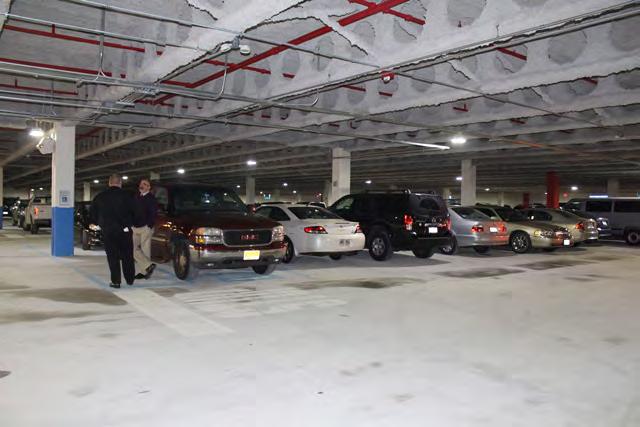

Multi-level structural systems vary from poured in place concrete, to precast to steel or a combination of these system to create a hybrid structural system. Georgia Ave and “H” Street were the first 2 Multi-levels in DC to be constructed. Although the projects were running concurrently the structural systems were completely different from each other. Miami was different as well and we ended up utilizing precast concrete. When it comes to multi-level, there is not one system that fits all scenarios. Geography, coupled with local resources, and labor conditions all contribute to decisions in the appropriate structural system to be utilized.
“H” Street & Fort Totten” were a mixed use structure requiring the lower levels of the structure to be poured in place concrete to create a fire rated podium to allow 4 residential stories of wood construction above it. This approach required significant coordination with the developers and their A/E design teams. We collectively worked together too simultaneously to ensure we had all the structural openings, core holes, etc., coordinated. Coring holes and or cutting post installation is a very costly alternative since so much infrastructure is buried in the concrete slabs. Post coring requires x-raying to avoid cutting rebar’s, conduits, etc.
“Georgia Ave” was a much simpler multi-level, it had no residential above. The entire lower level was parking. The foundation walls, garage level slab and the garage structural columns were all poured in place concrete. In lieu of steel joists and steel girders we utilized castellation beams with metal decking to support the floor above. The castellation beams and decking only required 1” of fireproofing to meet the required fire ratings. It is important to note that spray-on fireproofing also doubles as an insulation material. Therefore, although the vertical stems of the castellation beams only required 1” of fireproofing, the deck had 3” of fire proofing. Another important feature to note that increasing the thickness of the fireproofing did not require any special systems or meshes, just additional spray. The castellation beams also helped with all the piping systems from plumbing to sprinkler systems by allowing those systems to run through the castellation’s of the beams (the circular openings) rather than below them further restricting vehicle clearance heights. The entire main sales floor was basically proto, all steel columns and girders, bar joists and metal decking.
On the “Midtown Miami “ project we collectively decided that the best approach is to build a conventional foundation system but in lieu of poured in place concrete to go vertical, we decided to utilize precast double tees and precast wall systems. We incorporated a simple 60’ bay spacing that extends vertical to the upper level parking deck. Precast systems require poured toping decks and waterproofing directly above an occupied space (sales floor). However, the top level parking does not require a topping slab. It is very important to note that the precast double tees utilize 5000 psi concrete making the floor system virtually water tight just by the nature of the psi of the concrete. Where the double tees come together the joints are caulked on both the upper and lower face to meet the fire rated requirements but also double as additional insurance against water penetration.

Furthermore, these joints on the highest level exposed to the elements are also crowned with capping concrete to help protect the precast butt joints, further enhancing the protection from the elements.
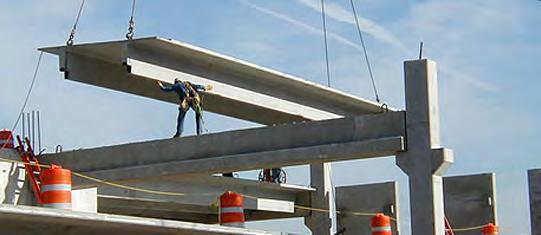
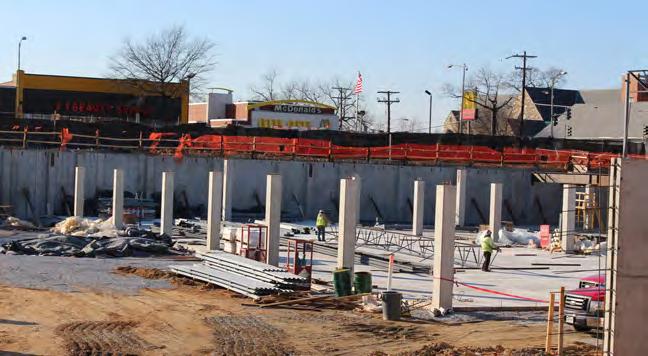
The utilization of precast added even more benefits. Aside from being less expensive than poured in place, it will be erected so much faster and enclosing the building so much quicker. Overall from a sustainability standpoint there is less construction duration, less construction noise to mitigate, and better quality control. The only inconvenience is having a local staging area to house the panels during erection. In our case the contractor has an adjoining lot to store those trailers.
This building has various brick finishes throughout, the various façades incorporate glazed to non-glazed colored brick finishes. To help improve the quality control, fabricating precast panels with brick inlays proves to be the best method to control quality and consistency because you are building it in an enclosed environment with a quality control team overseeing the completion of each component. An all-round win for the team!
When we started the design of Georgia Ave, the local professional, the local contractors and developers were all pushing us to incorporate a poured in place concrete structural system with a 4” topping slab along with a 30’ bay spacing. It was obvious that these individuals recommend what they knew. They were certainly not familiar with large retail box design and the parking efficiency associated for the success of operating a store of that size. Pushing boundaries was extremely important. Although we had an extremely experienced and qualified builder/developer they were unfamiliar with castellation beams. In the end, as they learned more about the structure they embraced it and quickly came to the same conclusion that it was the best system to utilize. Also, since most of the supercenter in general is merchandize it was not necessary to pour a double slab and sandwich the installation. This would have just added to the structural cost without adding any benefits. Unfortunately, this great system, just went out of business!
Lastly, when working in a mixed use structures (podium) with a developer be cautious with their A/E team. Being familiar with high and low rise buildings, all infrastructure works its way to the ground floor and the garage level ceilings. Make sure they are given appropriate zones in the ceilings for their systems and equipment with express instructions that they may not be able to push the envelope. This is probably the biggest hurdle to overcome in a multi-level design when there are floors above you. These developer A/E’s are extremely talented but most likely unfamiliar with issues facing a grocery tenant. The majority of issues that stem from these multi-levels originate from a lack of coordination from the developer’s A/E’s and from their inexperience with large retailer in urban environments.


More than ever, Walmart’s goal to be supplied 100% by renewable energy is the right goal, and they know that renewables combined with energy efficiency is especially powerful: for Walmart’s customers, for their shareholders and for the future of generations to come. Walmart envisions a world where people don’t have to choose between energy they can afford and energy that’s good for communities and the planet. Global energy predictions indicate costs could increase twice as fast as Walmart’s anticipated store and club growth. Finding cleaner and more affordable energy is vital to everyday low cost. Scaling renewable energy while accelerating energy efficiency is Walmart’s vision for a more sustainable world and is the right direction for their business.
Walmart’s aspirational goal of achieving zero waste across their global operations is bold, but they continue to make measurable progress. In the U.S., more than 81% of the materials that flow through their stores, clubs, and distribution centers is being diverted from landfills. Their operations in Japan and the U.K. lead the way with a diversion rate of more than 90%, while Walmart Canada and Walmart Mexico divert more than 70%.
MMA was ecstatic to have achieved LEED CI Silver for the H Street Supercenter, one of the first two Walmart’s ever built in DC, and the first store in Walmart’s global fleet to achieve Certified Interiors Silver distinction. Already widely recognized for our “out-of-the-big-box” thinking, MMA is a leader in rethinking the design industry’s traditional approach to retail architecture. Walmart along with MMA saw “H Street” as an opportunity to take that “out-of-the-big-box” thinking a step further, and take advantage of the opportunities for implementing sustainable design in an urban setting. Initially the goal was to achieve Certified and with the team’s overall collective collaboration we were successful in raising the bar to Silver. The project team not only complied with the DC Green Building Act, which requires all commercial buildings to be LEED Certified. We made it a point to go above and beyond that requirement and pursue Silver. The project team accomplished this goal in large part by thinking outside the big box and capitalizing on opportunities for sustainable design innovation. An itemization of these sustainable strategies is as follows:

Innovation - Rainwater Use for Cooling Tower Make Up: Because of the high consumption of water during cooling season, evaporative cooling towers and cooling water systems are an excellent use for water harvested from rainwater or greywater. Walmart is utilizing the roof area of the building to collect rainwater. The water is filtered and treated as required and stored until needed. Water from the harvesting system storage tank is directed to the cooling tower make-up inlet. This results in a reduction of water use and a reduction of stormwater runoff into the city’s sewer system.
Innovation - Reduce Mercury in Lamps: Walmart established and maintained a toxic material source reduction program to reduce the amount of mercury brought into the building through the purchase of light bulbs. The goal of the program is to maintain mercury content of all mercury-containing light bulbs below 90 picograms per lumen hour, on weighted average, for the building and grounds.


This report contains the results of the technical review of an application for LEED® certification submitted for the specified project. LEED certification is an official recognition that a project complies with the requirements prescribed within the LEED rating systems as created and maintained by the U.S. Green Building Council® (USGBC®). The LEED certifcation program is administered by the Green Building Certification Institute (GBCI®).
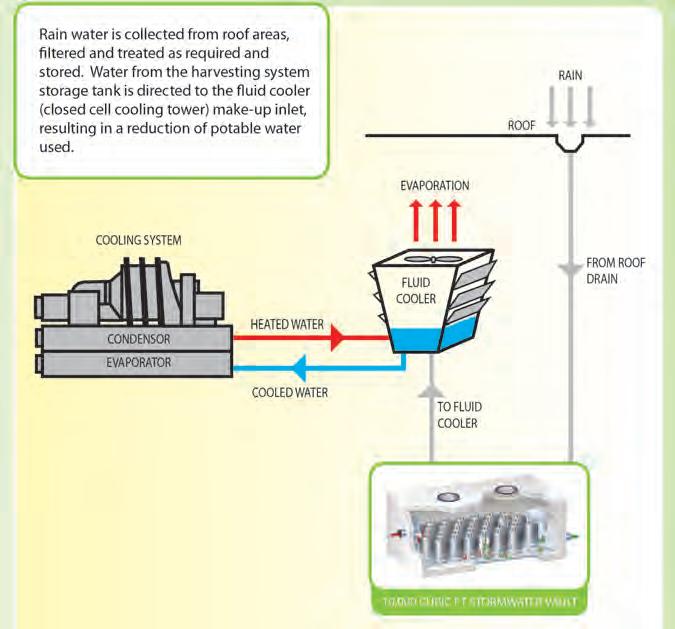
The pilot program required a 95% diversion rate, and after construction our construction demolition recycling rates were verified to be an average of 96.17%. The project team worked with a waste management company to capture and recycle as many metals, woods, plastics, floor and ceiling tiles, concretes, etc. generated as part of our demolition and construction to be reused. In addition to the pilot credit, Walmart’s sustainable facilities program takes steps further by implementing a Super Sandwich Bales and compactors program to condense large volumes of materials to make them easier to manage and haul. Walmart’s goal is to send zero waste to landfills while maximizing all waste streams by recycling as much as possible. Food scraps are separated from other discarded items and, depending on their quality, sent to food banks or third party processors as they have beneficial reuse/recycling value.
Several bus stops are located within ¼ mile of the store and metro stops are within walking distance also. AMTRAK and regional commuter rail services are located at Union Station which is within a ½ mile from the store. These multi-modal transit options help to promote a pedestrian-friendly, age-friendly environment as well as create easy access via mass transit. Bike racks are also provided to promote alternative transportation to driving and showers and changing rooms are provided for on-site employees. A Capital Bike Share rack is also located on-site. The team pursued the exemplary point for doubling transit ridership.

We went above and beyond to meet not only the minimum in lighting power reduction, but to reduce lighting power usage store-wide by 40%.
Aside from innovative and exemplary points, the project team diligently met each prerequisite and pursued credits in every LEED category. From sustainable site development to indoor air quality, the longevity and health of the surrounding environment and community members – both customers and employees alike – were priorities when making design decisions.
A major design feature of this project is how it addresses rainwater retention and reuse. Two systems have been designed to retain 102 thousand gallons of rainwater. An underground stormwater management tank was provided in addition to two landscaped courtyards planted with native/adaptive plants and trees. Water stored in the underground stormwater management tank is harvested as makeup water for Walmart’s cooling towers, thereby reducing water demand. Water quality control is provided using the retention of 8,987 CF in the stormwater vault and 4,657 CF in the rooftop green areas. The vault and the rooftop areas combine to provide 35% more retention capacity than is required. The retained water is pumped to a treatment system before entering the cooling tower, where the water is used for the cooling system before evaporating into the air. As a result, this system contains 100% of the Total Suspended Solids (TSS) within the vault, which will be removed from the vault through semi-annual inspections.
In order for the store to achieve a water use reduction of 35%, the restroom sinks were fitted with sensor-activated ½ gallon per minute (gpm) high efficiency faucets. These faucets regulate water flow and reduce water usage by 78% compared to mandated 1992 EPAct Standards. Electronic sensors regulate a maximum 10 second run time per cycle. It is estimated that this technology allows users to adequately wash their hands using less than 1 pint of water. In addition, there are water turbines built into the faucet. During use, waterflow through these turbines generates the electricity needed to operate the sensors.
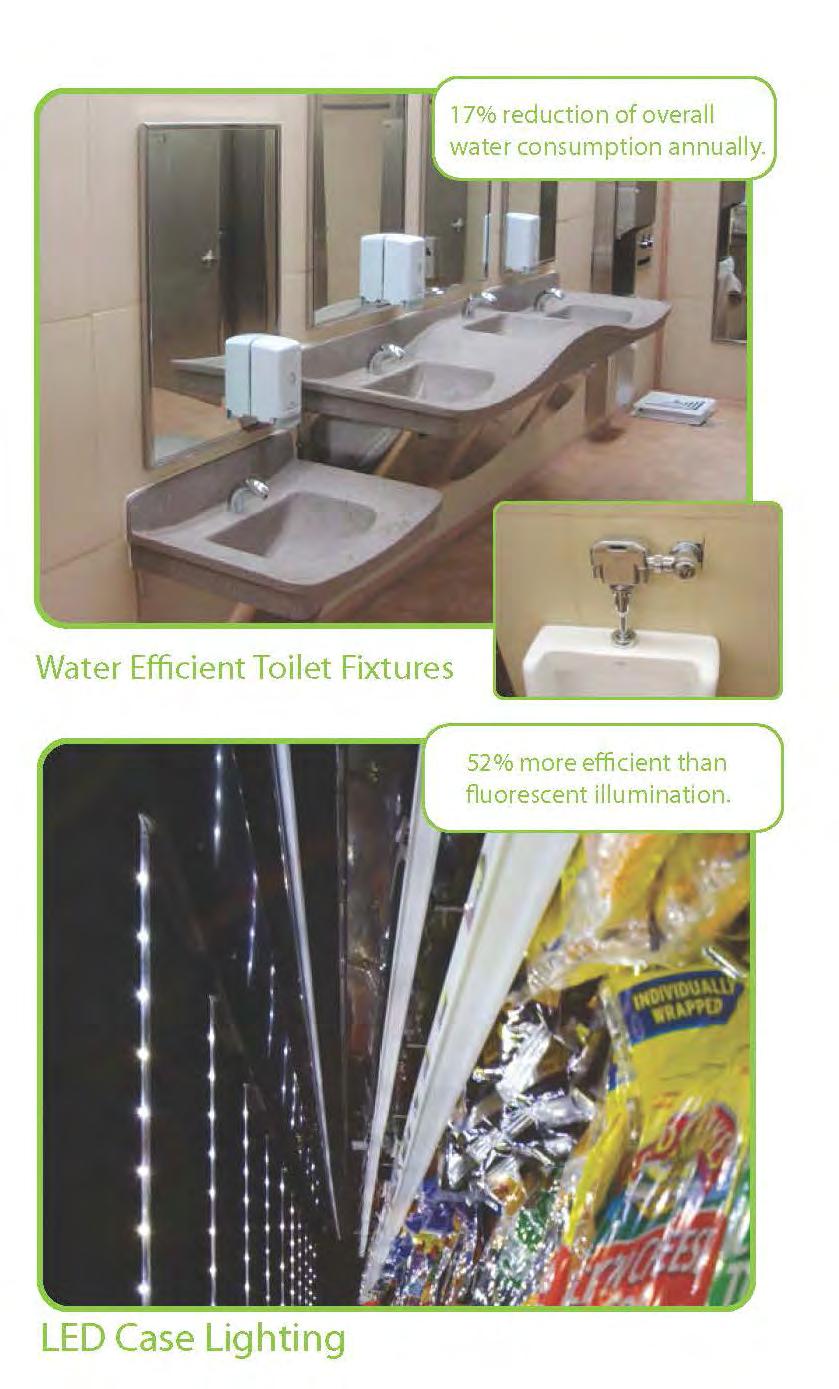
High efficiency urinals were also installed that use only 1/8 gallon (one pint) of water per flush. This fixture yields 87% water savings per flush versus 1.0 gallon per flush urinals. High efficiency toilets that use 1.28 gallons of water per flush were also installed. The fixture yields a 20% reduction in water usage over current mandated the 1992 EPAct, which requires minimum 1.6 gallons per flush fixtures. Automatic flush valves on the toilets have water turbines similar to the low-flow faucets, which generate the power required to activate the flush mechanism. These turbines not only save energy but also save material by eliminating the need for electrical conduits and wiring otherwise required to power automatic flush valve sensors.
In addition to the measures being taken to increase efficiency in building water use, commercial processes such as ice making were also targeted for water use reduction. High efficiency ice machines are utilized in kitchen areas. The high efficiency ice machines require only 17 gallons of water to produce 100 pounds of ice – a 30% reduction from the industry standard 25 gallons per 100 pounds. It is estimated that these water conservation measures will reduce the overall water consumption by an additional 17%. This is expected to save anywhere from 250,000 to 500,000 gallons of water annually at this Walmart.
The H Street Supercenter had all building energy-related systems verified to be installed, calibrated, and performing according to the Owner’s Project Requirements (OPR), Basis of Design (BOD), and the construction documents. This was all led by an independent third-party Commissioning Authority (CxA).
The energy performance in this store exceeds the 10% improvement over the energy performance requirement of ASHRAE/IESNA Standard 90.1-2007. No CFC-based refrigerants were used. The project team utilized high efficiency LED lighting that requires approximately 0.58 watts per square foot on average. This will provide an energy reduction of over 60% from the standard baseline.
This H Street Supercenter not only has a main total electrical usage meter at the main service switchgear, but also has sub-meters to monitor the HVAC equipment, lighting, refrigeration parallel racks, and the dehumidification HVAC units. These meters will be able to confirm the different systems’ energy usage after a period of no less than one year of operation and compare that to the baseline performance to make sure we are meeting and or exceeding the required percentages.